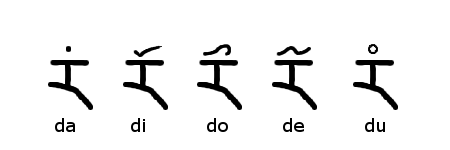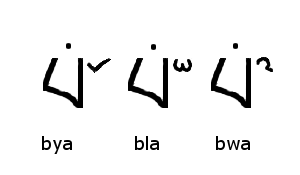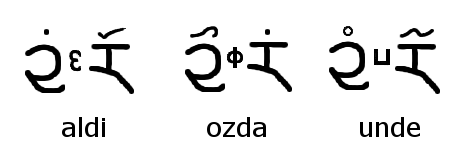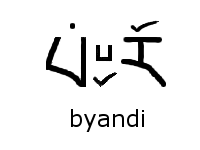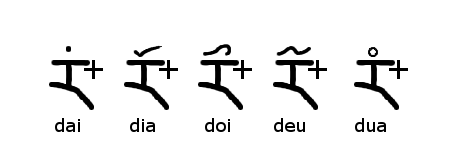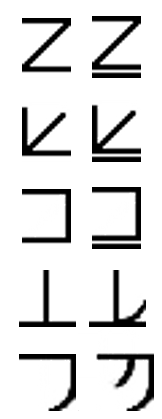The script of Seuna
Consonants
These are the 17 consonants. The ampersand "@" represents a glottal stop.
These 17 shapes have been more or less copied from Tibetan. These figures from the Tibetan alphabet was chosen as I feel that they are very distinct from each other but at the same time seem to have a common theme.
There is no correspondence between the phonetic values I give them and how they are pronounced in Tibet.
There is also no correspondence between how a sound "feels" and how it is written. If that were the case "s" would be extremely smooth, the nasals would be quite smooth and "k", "p" and "t" would be extremely angular.
There is no scheme that gives these symbols common elements corresponding to common articulation methods. However it can be noted that "b", "p" and "m" have a common element. As do "h" and "@". Also "g" and "y" are quite similar and in language "g" to "y" is a not uncommon sound change.
Vowels
The vowel marks are given below. They are written above the consonant that they follow. According to approved articulation, no syllable should begin with a vowel ; there should be a glottal-stop then a vowel. However to drop the glottal-stop seems to be quite common, in which case the first figure given in the consonants list is merely a place-holder to mount the vowel on.
Off-gestures
An off-gesture (or off-flurish) is when a consonant is immediately followed by "y","l" or "w". Off-gestures only occur word initially and are restricted to certain letters (see "initial consonant clusters" in "Seuna word shape"). The off-gesture is indicated by a mark placed just to the top right of the main figure (see below).
On-gestures
An on-gesture (or on-flurish) is when a non-initial-consonant is preceded by "l", "s" or "n". These on-gestures co-occur with most consonants but a very few combinations are disallowed(see "mid consonant clusters" in "Seuna word shape").
The on-gesture is indicated by a mark placed just to the left of the figure that they are combined with(see above).
Combining off-gesture with on-gesture
Most words take the form of two consonant figures. This form of word is called a "couplet".
In a couplet, it is forbidden for the first figure to have an off-gesture and the second figure has an on-gesture. The word shown below is not allowed.
Diphthongs
The diphthongs are written as shown below.
The diphthong au is represented by a symbol which is a sort of a combination of the a mark and the u mark. This is the one diphthong that doesn't have a following cross.
Reduced "couplets"
In the Seuna writing system certain couplets are "reduced". That is they are always written without any vowel signs.
Now in Seuna there are 1241 possible couplets.
For example the word for "book" is caito, which you would expect to be written 
However this word is is the commonest couplet with the letters "CT" so it is shorn of its vowels. It is always simply written as 
All the other couplets with the letters "CT" carry their vowels as normal. For example ceta meaning "petal" is written 
Other Symbols
Seuna is not purely a phonetic scripts. Many particles and case markings have their own symbol. The thinking behind this is for ease of interpretation. Instead of the brain having to do "symbol" => "sound" => "meaning", in Seuna it does "symbol" => "meaning" directly.
There are about 60 or 70 of these "symbols of meaning".
As an example I give the ones for the pronouns below.
| I, me | mi | we, us | mia |
| you | yu | you(pl) | yua |
| he/she, him/her | na | they them | wa |
| it | to | they | ton |
| you and me | myu | we | myun |
Reduced compounds
We have seen already how the most common "couplets" are shorn of their vowels. This process is taken further in compound words.
For example take kia meaning "sun" and swo meaning "day". They are shown below when they appear as independent words.
Now being singlets these words can never be reduced. However when compounded the are reduced. There is no other compound of the form "K.S".
When these words are joined together in a compound they mean "the first day of the Seuna week" and are pronounced kia.so
For another example take ki'o meaning "yellow" and noi meaning "week". They are shown below when they appear as independent words.
Now ki'o is a pretty common word but XXXX meaning xxxx is even commoner so XXXX is represented by "K@".
noi being a singlet is never reduced.
However when they are compounded (yellow.week is the 5 week of the month)the word must be reduced. There are no other compounds of the form "K@.N"
(Actually there could be other compound words of the form "K@.N" but they are not as common as the word meaning the fifth week of the month.
Notes on my orthography
When a glottal stop is word initial, in my English representation of a Seuna word, I use the sign "@" When a glottal stop is none word initial, in my English representation of a Seuna word, I use an apostrophe.
When I write Seuna compound words in English I use a fullstop to represent the Seuna symbol that is always inserted between the components.
See "Notes on compounds in Seuna"
Notes on the phonology of compounding
Stress is on the first syllable of a word. In a compound word the rightmost component will loose its stress.
Also if the initial consonant of the rightmost component has an off-glide, it will loose that off-glide. Hence in the above example we see swo => so
Also if the initial vowel of the rightmost component is a diphthong, it will change to a simple vowel. Hence in the above example we see noi => no
Notes on the phonology of compounding three or more element
The low level splits have the rule as above.
The high level split is represented in the script by the symbol "small square".
This symbol is actually pronounced. It is pronounced as "n".
The consonant after this "n" will be voiced if possible.
For example ;-
t would change to d
tw would change to dw
f would change to v(no such sound in Seuna)
but s would change to z
ky would not change to gy (gy is not allowed). ky would stay as ky
Notice there is no loosing of off-gestures or diphthongs at the top level split.
Examples chineseartdealer ??? carmaintenancetrainingcourse???
Notes on compounds in Seuna script
In every compound word, a small circle is placed at mid height, between the two components of a compound word.
Other
For example "to walk" = dono. This happens to be the word choosen from all the two syllable words with initial event D and secondary event N.
bundo = building, bunda = to build
Vowels and initial-consonant-tail-gestures and secondary-consonant-head-gestures will be represented as lower case letters.
tolnu = to grind => TolNu
dono = to walk => DN and not (DoNo)
Minor heading
Index
- Introduction to Seuna
- Seuna : Chapter 1
- Seuna word shape
- The script of Seuna
- Seuna sentence structure
- Seuna pronouns
- Seuna nouns
- Seuna verbs (1)
- Seuna adjectives
- Seuna demonstratives
- Seuna verbs (2)
- Asking a question in Seuna
- Seuna relative clauses
- Seuna verbs (3)
- Methods for deriving words in Seuna
- List of all Seuna derivational affixes
- Numbers in Seuna
- Naming people in Seuna
- The Seuna calendar
- Seuna units

